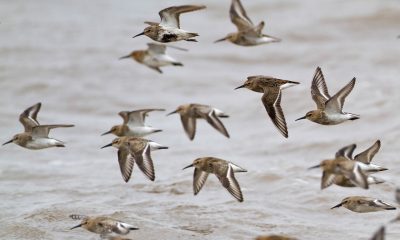Scientists identify the ‘superspreaders’ of the animal kingdom
Researchers have mapped how infectious diseases spread among wildlife populations in areas where humans and wildlife live in close proximity.
Published
2 years ago onBy
Talker News
By Stephen Beech via SWNS
Wild monkeys that live in large groups alongside human settlements are the disease “superspreaders” of the animal kingdom, according to a new study.
Researchers have mapped how infectious diseases spread among wildlife populations in areas where humans and wildlife live in close proximity.
They found that monkeys with the most human interactions are responsible for the largest outbreaks.
The research team says it is because locations where monkeys and humans come into close contact, typically around sources of food, can attract monkeys from different groups and sub-groups.
It is at these human-wildlife hotspots that monkeys closely interact with monkeys they wouldn’t regularly mix with, leading to larger outbreaks.
A rising global population meaning that human settlements increasingly encroach on the natural ranges of wild animals.
There is growing risk of both zoonotic diseases that “spillover” from wildlife to humans and zooanthroponotic diseases that “spillback” from humans and cause outbreaks among wildlife.
The study, led by Dr. Krishna Balasubramaniam of Anglia Ruskin University (ARU), used computer models to simulate how infectious diseases may spread among monkeys living in urban areas.
It is the first research to use simulations to compare disease spread through animals’ social behavior, to disease spread through animals’ tendencies to congregate around and interact with humans.
The research team, including academics from the University of California, Davis, monitored the behavior of rhesus macaques, long-tailed macaques, and bonnet macaques in northern India, Malaysia, and southern India.
In these locations, wild macaques frequently share space with humans, and their interactions with people often focus around accessing food.
The researchers gathered detailed behavioral data on interactions between humans and individual monkeys as well as interactions between monkeys within the same group, within which individuals have strong social connections.

The information was collected from 10 separate groups of macaques across the three Indian and Malaysian locations.
The data was fed into mathematical Susceptible-Infected-Recovered (SIR) epidemiological models to simulate the impact of outbreaks of human diseases of varying transmissibility such as the influenza virus, Coronaviruses, and the measles virus.
Computer simulations were run 100,000 times in total across the 10 groups and across the different human diseases, and the vulnerability of the macaque populations to human-induced disease outbreaks was evaluated.
The study found that the size of the outbreak was positively predicted by the centrality within the group of the first-infected macaque – if that individual is better connected within its social network, it would lead to a larger outbreak.
Dr. Balasubramaniam said the second key finding was that the centrality of the first-infected individual, based on both its congregations with other monkeys around humans and its interactions with humans, plays a greater role in predicting the scale of the outbreak than how central it is within its own group.
He said: "This is because macaques may congregate around human-provisioned food alongside other macaques with whom they would otherwise not interact that often.
"The study revealed that these situations seem to create additional pathways for disease transmission and therefore lead to larger outbreaks.".
The researchers believe the work could be "vital" in helping to identify individual monkeys that are the most sociable, and tend to congregate around and interact with humans the most.
They said that targeting these with vaccinations or other forms of medical treatment could potentially protect both macaque populations and humans in areas where they live in close proximity.
Dr. Balasubramaniam said: “COVID-19 has highlighted the importance of understanding infectious disease transmission among wildlife populations in urban and peri-urban areas.
"Population expansion has increased the contact between humans and wildlife, and these human-wildlife interfaces are widely recognized as ‘hotspots’ for the transmission of diseases across a variety of species.
“Our research focused on the potential impact of a human-borne disease spreading through wild macaque populations.
"Being so closely related to humans, macaques are highly vulnerable to the same diseases that infect people. Indeed, previous work by other researchers established that macaques may be infected by human gastrointestinal and respiratory pathogens.
"Here we showed how respiratory pathogens, in particular, might spread through macaque populations, and specifically how their behavior might influence such spreading.
“Through fieldwork and modeling, our research identified which individuals are most likely to act as ‘superspreaders’ of disease, leading to larger outbreaks.
"How central the individual was within its own group had an effect on the size of the outbreak, but interestingly the stronger predictor of whether a macaque would go on to cause a large outbreak was its tendency to congregate around humans with macaques from other sub-groups."
He added: “Sources of human-provided food can act as a ‘honeypot’ and lead to macaques coming into very close contact with individuals with whom they may otherwise have less contact, for instance, monkeys from other families or sub-groups.
“As well as being ‘superspreaders’ within their species, these individuals with the most human contact also pose the highest risk for interspecies disease transmission events, either from humans into wildlife, or vice-versa.
"These would be the most effective targets for disease control strategies such as vaccination or antimicrobial treatment.”
The findings were published in the journal Scientific Reports.
Stories and infographics by ‘Talker Research’ are available to download & ready to use. Stories and videos by ‘Talker News’ are managed by SWNS. To license content for editorial or commercial use and to see the full scope of SWNS content, please email [email protected] or submit an inquiry via our contact form.
You may like


Study finds acid reflux drugs may trigger migraines


Giant prehistoric salmon used tusk-like teeth to fight off predators


Evidence of Earth’s magnetic field dates back 3.7 billion years


New research reveals early galaxies evolved much faster than thought


Majority of American moms and dads feel lonely and burned out


Hospital patients treated by women doctors are less likely to die
Other Stories


Climate change stopping birds from migrating
Historically, harsh conditions in Europe would see huge numbers of birds migrating to the relatively mild conditions of a British...


What is the perfect movie length?
Americans are officially over marathon movies. According to new research, the perfect movie length is just 92 minutes. The poll...


Study finds acid reflux drugs may trigger migraines
Scientists found acid-reducing tablets may cause headaches.


Photography contest highlights world’s best engagement photos
Photographers from around the world were invited to submit images to the 2024 competition.


Cancer survivors from poorer places at higher risk of second cancer
Female breast cancer survivors diagnosed under the age of 50 were especially at risk of developing a second cancer.
Top Talkers

 Parenting1 week ago
Parenting1 week agoSingle mom details struggles of feeding her 12 kids

 Lifestyle6 days ago
Lifestyle6 days agoWoman regrets her tattoo nightmare: ‘It’s horrendous’

 Good News3 days ago
Good News3 days agoDisabled student takes first steps in 10 years on graduation stage

 Health3 days ago
Health3 days agoNew study reveals ‘old age’ begins later than it used to

 Wildlife2 days ago
Wildlife2 days agoClever elephant returns visitor’s shoe after falling into enclosure

 Broadcast1 week ago
Broadcast1 week agoHow hard is it for Americans to live sustainably?

 Money1 week ago
Money1 week agoOver 40% of Americans have no clue what a 401k is

 Environment1 week ago
Environment1 week agoHow hard is it for Americans to live sustainably?
